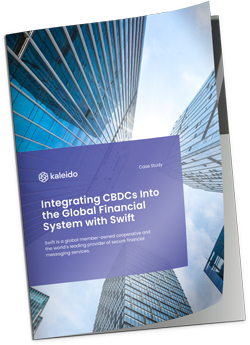

Cross-chain interoperability is crucial in today's blockchain world. It allows different blockchain networks to communicate and transact with each other, breaks down operational silos, and enables a more connected and efficient business ecosystem.
Highly-connective applications are also better positioned for future success as the lines between public and private blockchain continue to blur.
Here we’ll look at the leading technologies powering blockchain interoperability, and help you find which technology might be best for you.
A trusted or centralized bridge in the blockchain context is a mechanism operated by a trusted entity, such as an exchange or clearing house, which facilitates the transfer of data or assets between different blockchain networks.
Kaleido provides a trusted bridge interop hub as part of the product offering. This type of bridge is particularly relevant in enterprise scenarios such as financial services where the operator is already a key player in the ecosystem and is trusted due to its established role and adherence to regulatory policies. Examples include institutions in finance like Swift, DTCC, Nacha, or a central bank.
By monitoring events on one chain and executing corresponding transactions on another, these trusted bridges efficiently link disparate blockchain networks while leveraging the trust and authority of the central operator.
Trusted bridges offer fast transactions and easy integration, making them a great option for modernizing existing industry ecosystems.

A trustless or decentralized bridge operates through a network of smart contracts and relayers, working collectively to connect different blockchain networks. This system functions by capturing events on one blockchain (the source chain) and using a network of relayers, which operate without a central authority, to execute corresponding actions on another blockchain (the target chain).
Decision-making within this relay network is decentralized, ensuring that operations are carried out in response to verified events on the source chain.
This structure allows for a trustless and distributed approach to blockchain interoperability, aligning with the fundamental principles of decentralization in the blockchain world.
Trustless bridges distribute control among multiple parties, enhancing security and trust at the expense of potentially slower transaction speeds and more complex integration processes.
You can read more about the benefits and risks of bridges on our blog here.
Atomic Swaps are a method of enabling cross-chain transactions, based on Hashed Timelock Contracts (HTLCs). These swaps involve two corresponding HTLCs on the chains involved in the transaction, using a hash lock combined with a time lock to ensure that the trade occurs simultaneously (atomically) on both ends.
This setup ensures that either both parts of the trade are completed or none at all, maintaining security without the need for intermediaries.
The security and execution of the trade are inherently guaranteed by the contract mechanisms themselves, making Atomic Swaps a trustless and decentralized method for exchanging assets across different blockchain networks.
Atomic swaps are limited by the need for compatible cryptographic mechanisms and can be less user-friendly.
When choosing technologies to connect across chains, you want to consider what level of decentralization your project demands, how quickly you need transactions processed, and the ease of implementation. Different bridging options may also be available depending on what protocol you choose to build with or what network you want to plug into.
The choice depends on balancing pros and cons and making trade-offs along the lines of speed, security, and decentralization.
If you want help understanding these technologies or choosing one to use on your next project, schedule a talk with one of our solution architects.
Set up a blockchain on our free trial and start testing your use case today.
Try It FreeSet up a blockchain on our free trial and start testing your use case today.
Try It Free


Set up a blockchain on our free trial and start testing your use case today.
Try It FreeSet up a blockchain on our free trial and start testing your use case today.
Try It Free
Your guide to everything from asset tokenization to zero knowledge proofs
Download Now
Learn how Swift, the world’s leading provider of secure financial messaging services, utilizes Kaleido in its CBDC Sandbox project.
Download Now

